Arab–Khazar wars
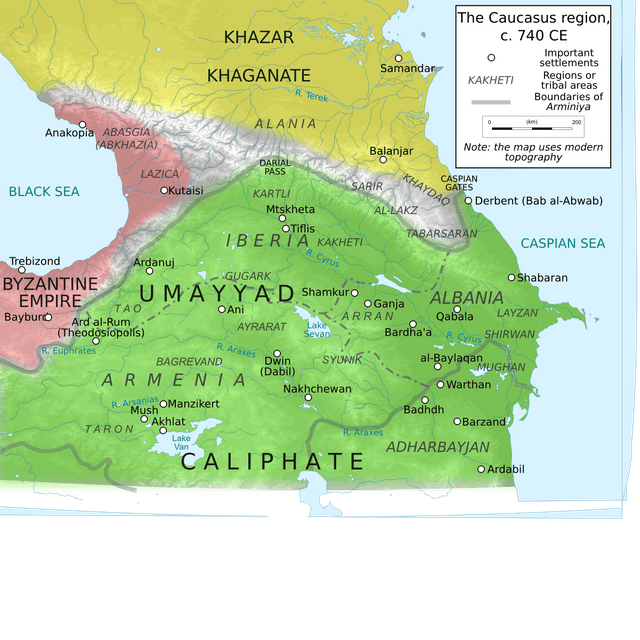
Arab–Khazar wars

| Arab–Khazar wars | |||||||
|---|---|---|---|---|---|---|---|
| Part of the Muslim conquests | |||||||
| |||||||
| Belligerents | |||||||
| Rashidun Caliphate (until 661) Umayyad Caliphate (661–750) Abbasid Caliphate (after 750) | Khazar Khaganate | ||||||
| Commanders and leaders | |||||||
|
| ||||||
The Arab–Khazar wars were a series of conflicts fought between the armies of the Khazar Khaganate and the Rashidun, Umayyad, and Abbasid caliphates and their respective vassals. Historians usually distinguish two major periods of conflict, the First Arab–Khazar War (c. 642–652) and Second Arab–Khazar War (c. 722–737),[6][7] but the Arab–Khazar military confrontation also involved sporadic raids and isolated clashes from the middle of the 7th century to the end of the 8th century.
The Arab–Khazar wars were a result of the attempts of the Umayyad Caliphate to secure control of Transcaucasia and the North Caucasus, where the Khazars were already established. The first Arab invasion, in the 640s and early 650s, ended with the defeat of an Arab force led by Abd ar-Rahman ibn Rabiah outside the Khazar town of Balanjar. Hostilities broke out again with the Caliphate in the 710s, with raids back and forth across the Caucasus Mountains. Led by the distinguished generals al-Jarrah ibn Abdallah and Maslama ibn Abd al-Malik, the Arabs were able to capture Derbent and even the southern Khazar capital of Balanjar, but these successes had little impact on the nomadic Khazars, who continued to launch devastating raids deep into Transcaucasia. In one such raid in 730, the Khazars inflicted a major defeat on the Umayyad forces at the Battle of Ardabil, killing al-Jarrah, but were in turn defeated the next year and pushed back north. Maslama then recovered Derbent, which became a major Arab military outpost and colony, before being replaced by Marwan ibn Muhammad (the future caliph Marwan II) in 732. A period of relatively localized warfare followed until 737, when Marwan led north a massive expedition that reached the Khazar capital Atil on the Volga. After securing some form of submission by the khagan, the Arabs withdrew.
The 737 campaign marked the end of large-scale warfare between the two powers, establishing Derbent as the northernmost Muslim outpost and securing Muslim dominance over Transcaucasia. At the same time, the continuing warfare weakened the Umayyad army and contributed to the eventual fall of the dynasty to the Abbasid Revolution a few years later. Relations between the Muslims of the Caucasus and the Khazars remained largely peaceful thereafter, apart from two Khazar raids in the 760s and in 799, resulting from failed efforts to secure an alliance through marriage between the Arab governors or local princes of the Caucasus and the Khazar khagan. Occasional warfare continued in the region between the Khazars and the Muslim principalities of the Caucasus until the collapse of the Khazar state in the late 10th century, but the great wars of the 8th century were never repeated.
| Arab–Khazar wars | |||||||
|---|---|---|---|---|---|---|---|
| Part of the Muslim conquests | |||||||
| |||||||
| Belligerents | |||||||
| Rashidun Caliphate (until 661) Umayyad Caliphate (661–750) Abbasid Caliphate (after 750) | Khazar Khaganate | ||||||
| Commanders and leaders | |||||||
|
| ||||||
Strategic background and motives
The Caucasus as a frontier between the steppe and the settled world
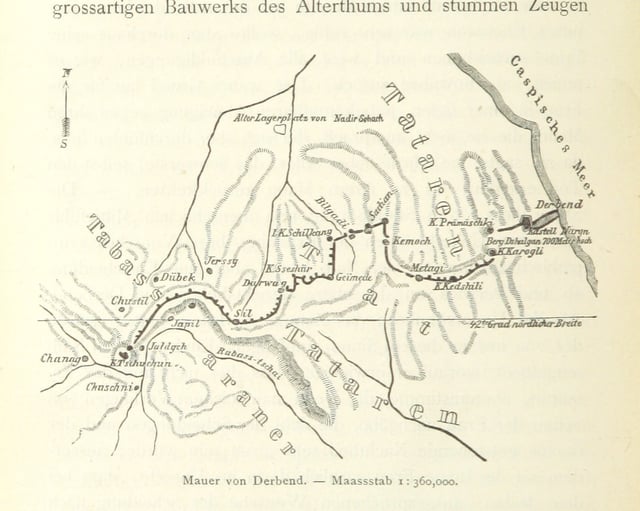
Map of the Sassanid fortifications of the "Caspian Gates" at Derbent, by Roderich von Erckert
The Arab–Khazar wars were part of a long series of military conflicts between the nomadic peoples of the Pontic–Caspian steppe and the more settled regions south of the Caucasus range. The two primary routes over the mountains, the Darial Pass ("Alan Gates") in the centre and the Pass of Derbent ("Caspian Gates") in the east along the Caspian Sea, have been used as invasion routes since Classical Antiquity.[5][8] Consequently, the defence of the Caucasus frontier against the destructive raids of the steppe peoples such as the Scythians and the Huns came to be regarded as one of the chief duties of imperial regimes of the Near East.[8] This is reflected in the popular belief among Middle Eastern cultures that Alexander the Great had with divine assistance barred the Caucasus against the hordes of "Gog and Magog". As historian Gerald Mako points out, the latter were stereotypical "northern barbarians", as conceived by the settled civilizations of Eurasia: "uncivilized savages who drank blood, who ate children, and whose greed and bestiality knew no limits"; should Alexander's barrier fail and Gog and Magog break through, the Apocalypse would follow.[9]
Starting with Peroz I (r. 457–484), the shahs of the Sassanid Empire built a line of stone fortifications to protect the vulnerable frontier along the Caspian shore; when completed under Khosrau I (r. 531–579), this stretched over 45 kilometres (28 mi) from the eastern foothills of the Caucasus to the Caspian Sea. The fortress of Derbent was the strategically crucial centre-point of this fortification complex, as evoked by its Persian name Dar-band, "Knot of the Gates."[10][11]
Opposing armies: the Arabs and the Khazars
The Turkic Khazars appeared in the area of modern Daghestan in the latter half of the 6th century, initially as subjects of the Turkic Khaganate, but following the latter's collapse, they emerged as an independent and dominant power in the area of the northern Caucasus by the 7th century.[11] As the most recent steppe power in the region, early medieval writers came to identify the Khazars with Gog and Magog,[12] and the Sassanid fortifications at Derbent as Alexander's wall.[11]
Like other Near Eastern peoples, the Arabs were already familiar with the legend of Gog and Magog, who appear even in the Quran (Yaʾjūj wa-Maʾjūj). Following the Muslim conquests, these perceptions were enhanced by incorporating many of the cultural conceptions of their new subjects.[13] The nascent Muslim Caliphate regarded itself as heir to the Sassanid, and to a lesser extent, Byzantine, tradition and "civilizational consciousness". As a result, the Arab caliphs also adopted the notion that, in the words of Mako, it was their duty "to protect the settled, i.e. the civilized world from the northern barbarian". This imperative was further reinforced by the Muslim division of the world into the "House of Islam" or Dar al-Islam and the "House of War" (Dar al-Harb), to which the pagan Turkic steppe peoples like the Khazars were consigned.[14][1]
Unlike their Byzantine and Sassanid predecessors, who simply sought to contain the steppe peoples through fortifications and political alliances, the Arabs were "expansionists interested in conquest". From the beginning, they actively pursued a northward expansion, quickly posing a direct threat to the survival of the Khazars as an independent polity.[15] The Khazars, on the other hand, followed a strategy common to their nomadic predecessors: while raids might reach deep into Transcaucasia, and even into Mesopotamia and Anatolia, they were not aimed at conquest, but rather "typical of nomads testing the defenses of their sedentary neighbors", as well as a means of gathering booty, the acquisition and distribution of which was fundamental to the maintenance of tribal coalitions. For the Khazars, the strategic stake of the conflict was control of the passes of the Caucasus.[16]
The eastern Caucasus range became the main theatre of the Arab–Khazar conflict, with the Arab armies aiming to gain control of Derbent (in Arabic, Bab al-Abwab or "Gate of Gates") and the Khazar cities of Balanjar and Samandar. Their locations have yet to be established with certainty by modern researchers, but both cities are referred to as Khazar capitals by different Arab writers, and may have functioned as winter and summer capitals respectively. It was only later, under the impact of the Arab attacks, that the Khazars moved their capital further north, to Atil (Arabic al-Bayda) on the mouths of the Volga.[17]
The opposing armies represented different military philosophies, which derived from the nature of their societies. Arab armies contained sizeable contingents of both light and heavy cavalry, [18] but relied primarily on their infantry, to the extent that the Arab cavalry was often limited to skirmishing during the initial phases of a battle, before dismounting and fighting on foot.[19] While the Khazars had adopted elements of the civilizations of the south and possessed towns, they remained a largely tribal and semi-nomadic power. Like other steppe societies originating in Central Asia, they practiced a very mobile form of warfare, relying on highly skilled and hardy cavalry. As the historian Khalid Yahya Blankinship writes, "the Khazars were to prove difficult opponents for the Muslims, perhaps partly because their state was not highly organized and thus did not have a center whose fall would bring about a sudden collapse and rapid surrender".[20]
Connection with the Arab–Byzantine conflict
To an extent, the Arab–Khazar wars were also linked to the long-lasting struggle of the Caliphate against the Byzantine Empire along the eastern fringes of Anatolia, a theatre of war which adjoined the Caucasus. The Byzantine emperors pursued close relations with the Khazars, which amounted to a virtual alliance for most of the period in question, including such exceptional acts as the marriage of emperor Justinian II (r. 685–695, 705–711) to a Khazar princess in 705.[21][22] The possibility of the Khazars linking up with the Byzantines through Armenia was a grave threat to the Caliphate, especially given its proximity to the Umayyad Caliphate's metropolitan province of Syria.[5] This did not materialize, and Armenia was left largely quiet, with the Umayyads granting it wide-ranging autonomy and the Byzantines likewise refraining from active campaigning there.[23] Indeed, given the common threat posed by the Khazar raids, the Umayyads found the Armenians (and the neighbouring Georgians) willing allies against the Khazars.[24]
Some Byzantinists, notably Dimitri Obolensky, suggested that the Arab expansion against the Khazars was motivated by a desire to outflank the Byzantine defences from the north, and envelop the Byzantine Empire in a pincer movement. However, this idea is rejected as far-fetched by modern scholars. As historian David Wasserstein comments, it is a scheme of extraordinary ambition, which "requires us to accept that Byzantium had succeeded already at this primary stage in persuading the Muslims that it could not be conquered", and furthermore that the Muslims possessed "a far greater knowledge and understanding of the geography of Europe" than can be demonstrated for the time in question. Mako likewise remarks that such a grand strategic plan is not borne out by the rather limited nature of the Arab–Khazar conflict until the 720s.[25][26] It is more likely that the northward expansion of the Arabs beyond the Caucasus was, at least initially, the result of the onward momentum of the early Muslim conquests, with the local Arab commanders seeking to exploit opportunities, haphazardly and without any overall planning. The expansion may even have been in direct contravention to caliphal orders, repeating a frequent pattern during this period.[27] From a strategic perspective, it is far more probable that it was the Byzantines who encouraged the Khazars to attack the Caliphate to relieve the mounting pressure on their own eastern frontier in the early 8th century,[24] as indeed Byzantium profited considerably from the diversion of the Muslim armies northwards in the 720s and 730s, resulting in another alliance through marriage, between the future emperor Constantine V (r. 741–775) and the Khazar princess Tzitzak in 733.[28][29][2]
Gaining control over the northern branch of the Silk Road by the Caliphate has been suggested as a further motive for the conflict, but Mako disputes this claim by pointing out that warfare declined at precisely the period of the greatest expansion of traffic along the Silk Road, i.e. after the middle of the 8th century.[32]
First Arab–Khazar War and aftermath
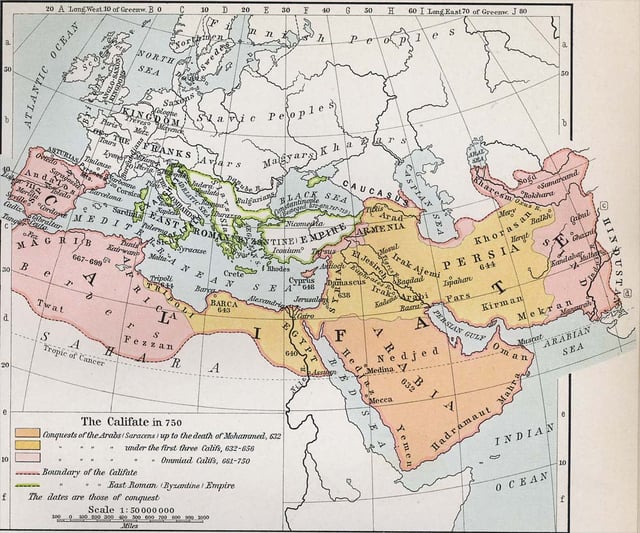
The expansion of the Muslim Caliphate until 750, from William R. Shepherd's Historical Atlas. Muslim state at the death of Muhammad Expansion under the Rashidun Caliphate Expansion under the Umayyad Caliphate Byzantine Empire
The Khazars themselves first campaigned in the Caucasus during the Byzantine–Sassanid War of 602–628, as subjects of the Western Turkic Khaganate. The Turks sacked Derbent and joined the Byzantines in their siege of Tiflis. Their contribution proved decisive for the eventual Byzantine victory in the war. For a few years afterwards, the Khazars exercised some control over Caucasian Iberia (approximately modern Georgia), Caucasian Albania/Arran (modern Republic of Azerbaijan) and Adharbayjan (modern Iranian Azerbaijan), while the western half of Transcaucasia, i.e Armenia, was in Byzantine hands. However, after the death of the Khazar or Western Turkic ruler in an internal conflict c. 630/632, the Khazar activity in eastern Transcaucasia ceased.[33][34]
The Khazars and the Arabs came into conflict as a result of the first phase of Muslim expansion: by 640, the Arabs had reached Armenia,[35][36] and in 642, they launched their first raid across the Caucasus under Abd ar-Rahman ibn Rabiah.[10][17] This raid reached Derbent, where, according to the History of the Prophets and Kings of al-Tabari, the Persian governor, Shahrbaraz, offered to surrender the fortress to the Arabs and even to aid them against the unruly native Caucasian peoples, if he and his followers were relieved of the obligation to pay the jizya tax. The proposal was accepted and ratified by Caliph Umar (r. 634–644).[37]
In 645/646, the Arabs defeated a Byzantine army, reinforced with Khazar and Alan contingents, in Armenia.[35] As a result, Arab authority in Transcaucasia was more firmly established in the early 650s: in 652 the Armenian nobility, led by Theodore Rshtuni, recognized the Caliphate's overlordship, and in 654, following an abortive Armenian uprising, Arab authority was extended over Iberia as well.[36]
Al-Tabari reports that the first Arab advance into Khazar lands occurred as early as 642, claiming that Abd ar-Rahman ibn Rabiah reached Balanjar, without suffering any losses, and that his cavalry raided up to 200 parasangs—about 800 kilometres (500 mi)—to the north of it, but both his dating and the improbable claim that the Arabs suffered no casualties have been disputed by modern scholars.[17][38] Based at Derbent, Abd ar-Rahman led frequent raids against the Khazars over the following years, but these were small-scale affairs, and no event of major note is recorded in the sources.[39] In 651/652, disregarding the instructions of the Caliph urging caution and restraint, Abd ar-Rahman led a strong army north, aiming to take Balanjar. The town was besieged for a few days, until the arrival of a Khazar relief force, coupled with a general sortie of the besieged forces, ended in a heavy defeat for the Arabs. Abd ar-Rahman (or, according to al-Baladhuri, Abd ar-Rahman's brother Salman) and 4,000 Muslim troops were left dead on the field.[40] Three years later, the Khazars repelled a retaliatory campaign under Habib ibn Maslama.[10] In the aftermath of these attacks, the Khazars abandoned Balanjar and moved their capital further north, in an attempt to evade the reach of the Arab armies.[41]
Due to the outbreak of the First Muslim Civil War and the priorities on other fronts, the Arabs refrained from repeating an attack on the Khazars until the early 8th century.[42] The Khazars, on their part, only launched a few raids into the Transcaucasian principalities that were loosely under Muslim dominion: in a raid into Albania in 661/662, they were defeated by the local prince, but in 683 or 685 (also a time of civil war in the Muslim world), a large-scale raid across Transcaucasia was more successful, capturing much booty and many prisoners. The presiding princes of Iberia (Adarnase II) and Armenia (Grigor I Mamikonian) were killed trying to oppose that raid.[7][43]
Second Arab–Khazar War
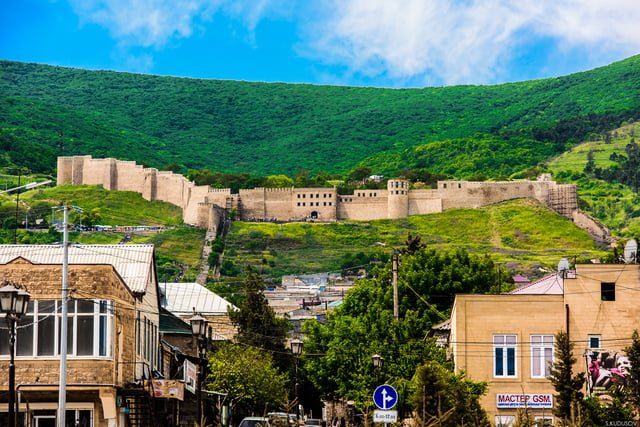
Naryn-Kala, the medieval citadel of Derbent, today
Relations between the two powers remained relatively quiet until the early years of the 8th century, by which time the stage for a new round of conflict was set: Byzantine political authority had been marginalized in the Caucasus, and the Caliphate tightened its grip on Armenia after the suppression of a large-scale rebellion in 705, placing it under direct Arab rule as the province of Arminiya. The Arabs and the Khazars now directly confronted each other for control of the Caucasus. Only the western parts of Transcaucasia, comprising modern Georgia, remained free from direct control by either of the two rival powers.[44]
Conflicting notices place the resumption of the conflict as early as 707, with a campaign by the Umayyad general Maslama, a son of Caliph Abd al-Malik (r. 685–705), in Adharbayjan and up to Derbent, which appears to have been under Khazar control at the time. Further attacks on Derbent are reported by different sources for 708 under Muhammad ibn Marwan and in the next year again by Maslama, but the most likely correct date for the recovery of Derbent is Maslama's expedition in 713/714.[17][45][46] Maslama then drove deeper into Khazar territory, trying to subdue the Huns living north of the Caucasus (who were Khazar vassals). The Khazars opposed him under the general Alp', but also launched raids to the south into Albania in response.[17][46] In 717, the Khazars raided in force into Adharbayjan, but they were driven back by the Arabs under Hatin ibn al-Nu'man. Hatin returned to the Caliph with fifty Khazar prisoners, the first such event recorded in the sources.[46][47]
Escalation of the conflict
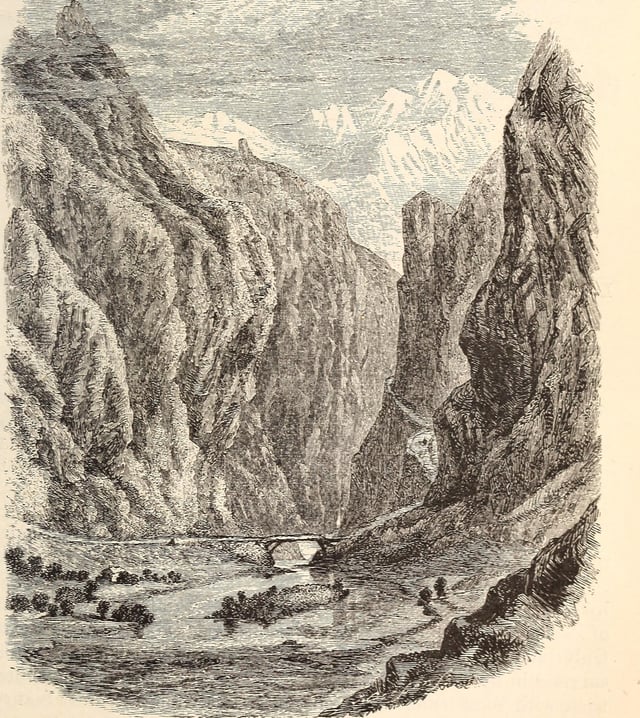
The Darial Pass c. 1861
In 721/722, the main phase of the war began. In the winter of this year, 30,000 Khazars invaded Armenia and inflicted a crushing defeat on the mostly Syrian army of the local governor Mi'laq ibn Saffar al-Bahrani at Marj al-Hijara in February and March 722.[48][49] In response, Caliph Yazid II (r. 720–724) sent one of his most celebrated generals, al-Jarrah ibn Abdallah, with 25,000 Syrian troops north.[50] On the news of his approach, the Khazars retreated to the vicinity of Derbent, whose Muslim garrison was still holding out. Advancing swiftly, al-Jarrah was able to enter Derbent without facing resistance, and launched raiding columns into Khazar territory.[51] Following with the bulk of his own army, he defeated a 40,000-strong Khazar army under Barjik, one of the Khazar khagan's sons, one day's march north of Derbent. Advancing north, the Arab army captured the settlements of Khamzin and Targhu, whose inhabitants were resettled elsewhere.[52] Finally, the Arab army reached Balanjar. The city had featured strong fortifications during the first Muslim attacks in the mid-7th century, but apparently they had been neglected in the meantime, for the Khazars chose to defend their capital by ringing the citadel with a laager of wagons. The Arabs broke it apart and stormed the city on 21 August 722. Most of Balanjar's inhabitants were killed or enslaved, but a few, including its governor, managed to flee north. The booty seized by the Arabs was so enormous that each of the 30,000 horsemen—probably an exaggeration by later historians—in the Arab army is said to have received 300 gold dinars from it.[46][53]
Some of the Khazar prisoners were drowned on al-Jarrah's orders. His army reduced the neighbouring fortresses as well, and continued their march north. The strongly garrisoned fortress of Wabandar capitulated in exchange for tribute, but the Arab advance was cut short before reaching the next important Khazar settlement, Samandar.[46][54] Despite their success, the Arabs had not yet defeated the main Khazar army, which like all nomad forces was not dependent on cities for supplies. The presence of this force near Samandar, as well as reports of rebellions among the mountain tribes in his rear, forced the Arabs to retreat to Warthan south of the Caucasus.[50][55] On his return, al-Jarrah reported on his campaign to the Caliph, but requested additional troops to defeat the Khazars, an indication of both the severity of the fighting and perhaps, according to Blankinship, that his campaign was not such a resounding success as portrayed in the Muslim sources.[50][55]
The sources are obscure on al-Jarrah's activity in 723, but he seems to have led another campaign north beyond Balanjar (which may be an echo, or possibly the actual date, of the Balanjar campaign of 722).[50][55] In response, the Khazars raided south of the Caucasus, but in February 724, al-Jarrah inflicted a crushing defeat on them in a battle between the rivers Cyrus and Araxes that lasted for several days.[50] The new caliph, Hisham ibn Abd al-Malik (r. 724–743), promised to send reinforcements, but eventually failed to do so. Nevertheless, in 724 al-Jarrah captured Tiflis and brought Caucasian Iberia and the lands of the Alans under Muslim suzerainty, becoming the first Muslim commander to campaign through the Darial Pass in the process. This secured the Muslims' own flank against a possible Khazar attack through the Darial, and gave them a second invasion route into Khazar territory.[56]
In 725, the Caliph replaced al-Jarrah with his own brother Maslama, who already held the post of governor of the Jazira.[46][57] The appointment of Maslama testifies to the importance placed by the Caliph on the Khazar front, for he was one of the most distinguished generals of the Umayyad empire.[58] For the time being, Maslama remained in the Jazira and was more concerned with operations against the Byzantines. In his stead, he sent al-Harith ibn Amr al-Ta'i to the Caucasus front. In 725, al-Harith was engaged in consolidating Muslim authority in Caucasian Albania, campaigning along the Cyrus against the regions of al-Lakz and Khasmadan. He was probably also preoccupied with supervising that year's census.[58][59] The next year, Barjik launched a major invasion of Albania and Adharbayjan. The Khazars even laid siege to Warthan, during which they employed mangonels. The use of such advanced siege machines shows, according to Blankinship, that the Khazars were "a militarily sophisticated nation, not a mere disorganized pack of barbarians". Al-Harith was able to defeat them on the banks of the Araxes and drive them back north of the river, but the Arabs' position was clearly precarious.[58][60]
This event prompted Maslama to take over personally the direction of the Khazar front in 727, where now he was faced, for the first time, by the khagan himself, as both sides escalated the conflict. Maslama, probably reinforced with more Syrian and Jaziran troops, took the offensive. He recovered the Darial Pass, apparently lost in the period since al-Jarrah's expedition in 724, and pushed on into Khazar territory, campaigning there until the onset of winter forced him to return to Adharbayjan.[61][60] Whatever Maslama's achievements in this expedition, they were not enough. The next year, when he repeated his invasion, it ended in what Blankinship calls a "near disaster". Arab sources report that the Umayyad troops fought for thirty or even forty days in the mud, under continuous rainfall, before scoring a victory against the khagan on 17 September 728. How great that victory was, however, is open to question, because on his return Maslama was ambushed by the Khazars, whereupon the Arabs simply abandoned their baggage train and fled headlong through the Darial Pass to safety.[62][63] In the aftermath of this campaign, Maslama was replaced yet again by al-Jarrah al-Hakami. For all his energy, Maslama's campaigning failed to produce the desired results: by 729, the Arabs had lost control of northeastern Transcaucasia and been thrust once more on the defensive, with al-Jarrah again having to defend Adharbayjan against a Khazar invasion.[62][64]
Ardabil and the Arab reaction
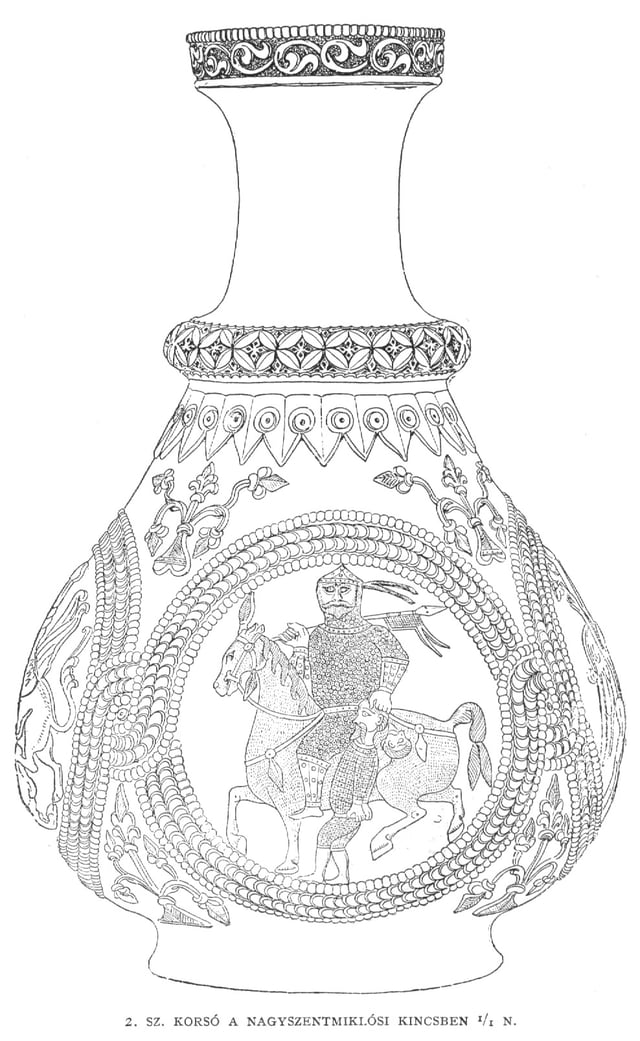
Ewer from the Treasure of Nagyszentmiklós showing an early medieval steppe warrior with captive
In 729/730, al-Jarrah returned to the offensive through Tiflis and the Darial Pass. Arab sources report that he reached as far as the Khazar capital, al-Bayda, on the Volga, but modern historians such as Dunlop and Blankinship consider this improbable. The Khazars launched a counterstroke under a certain Tharmach, which forced al-Jarrah to retreat south of the Caucasus once again to defend Albania. It is unclear whether the Khazars came through the Darial Pass or the Caspian Gates, but they managed to move around al-Jarrah's army at Bardha'a and lay siege to Ardabil. The city was the capital of Adharbayjan, and the mass of the Muslim settlers and their families, some 30,000 in total, lived within its walls. When al-Jarrah learned of this, he led his army in a rapid march south and engaged the Khazars outside the city walls. There, after a three-day battle on 7–9 December 730, al-Jarrah's army of 25,000 was all but annihilated by the Khazars under Barjik.[65][66][67] Al-Jarrah was among the fallen, and command passed to his brother al-Hajjaj, who was unable to prevent the sacking of Ardabil. The 10th-century historian Agapius of Hierapolis reports that the Khazars took as many as 40,000 prisoners from the city, al-Jarrah's army, and the surrounding countryside. The Khazars raided the province at will, sacking Ganza and attacking other settlements, with some detachments reaching as far as Mosul in the northern Jazira, adjacent to the Umayyad metropolitan province of Syria.[68][69][70]
The defeat at Ardabil was a major shock to the Muslims, who for the first time faced an enemy penetrating so deep within the borders of the Caliphate, and Caliph Hisham appointed the veteran military leader Sa'id ibn Amr al-Harashi to take command against the Khazars in the short term, while Maslama prepared to march against them. Although the forces he could muster immediately (including refugees from Ardabil who had to be paid ten gold dinars to be persuaded to fight) were small, Sa'id managed to recover Akhlat on Lake Van. From there he moved northeast to Bardha'a and south again to relieve the siege of Warthan. Near Bajarwan Sa'id came upon a 10,000-strong Khazar army, which he defeated, killing most of the Khazars, and rescuing the 5,000 Muslim prisoners they had with them. The surviving Khazars fled north, with Sa'id in pursuit.[71][72] Despite this success, Sa'id was relieved of his command in early 731 and even imprisoned for a while at Qabala and Bardha'a as a result of the jealousy of Maslama, whom Hisham had re-appointed as governor of Armenia and Adharbayjan.[73][74]
Maslama came to the Caucasus with many Jaziran troops and took the offensive. He restored the provinces of Albania to Muslim allegiance after meting out exemplary punishment to the inhabitants of Khaydhan, who resisted his advance, and reached Derbent, where he found a Khazar garrison of 1,000 men with their families installed. Bypassing the fortress, Maslama advanced north. Although the details of this campaign in the sources may be confused with that of 728, it appears that he took Khamzin, Balanjar, and Samandar before being forced to retreat again after a confrontation with the bulk of the Khazar army under the khagan himself. Leaving their campfires burning, the Arabs withdrew in the middle of the night, and in a series of forced marches covering twice the usual distance, reached Derbent. The Khazars shadowed Maslama's march south and attacked him near Derbent, but the Arab army, augmented by local levies, resisted their onslaught until a small picked force attacked the khagan's tent and wounded the Khazar ruler himself. Taking heart, the Muslims attacked and defeated the Khazars. It is probably this battle or campaign in which Barjik was reportedly killed.[75][76] Taking advantage of his victory, Maslama evicted the Khazars from Derbent by poisoning their water supply and re-founded the city as a military colony, garrisoning it with 24,000 mostly Syrian troops divided into quarters by the districts (jund) of their origin. After that he returned with the rest of his army (mostly the favoured Jaziran and Qinnasrini contingents) south of the Caucasus for the winter, while the Khazars re-occupied their abandoned towns. Despite the capture of Derbent, Maslama's record was apparently unsatisfactory for Hisham, who replaced his brother in March 732 with Marwan ibn Muhammad, who would later reign as the last Umayyad caliph in 744–750.[77][78]
In the summer of 732, Marwan led 40,000 men north into Khazar lands. The accounts of this campaign are confused: Ibn A'tham records that he reached Balanjar and returned to Derbent with much captured livestock, but the campaign is described in terms strongly reminiscent of Maslama's expeditions in 728 and 731, and its veracity is open to doubt. Ibn Khayyat on the other hand reports that Marwan led a far more limited campaign on the country immediately to the north of Derbent and then retired there to spend the winter.[79][80] Marwan was more active in the south, where he raised Ashot III Bagratuni to the position of presiding prince of Armenia, effectively granting the country broad autonomy in exchange for the service of its soldiers alongside the Caliphate's armies. This unique concession points, according to Blankinship, to the worsening manpower crisis faced by the Caliphate.[81][82] At about the same time, the Khazars and Byzantines strengthened their ties and formalized their alliance against their common enemy with the marriage of Constantine V to the Khazar princess Tzitzak.[83][84]
Final phase of the war: Marwan's invasion of Khazaria
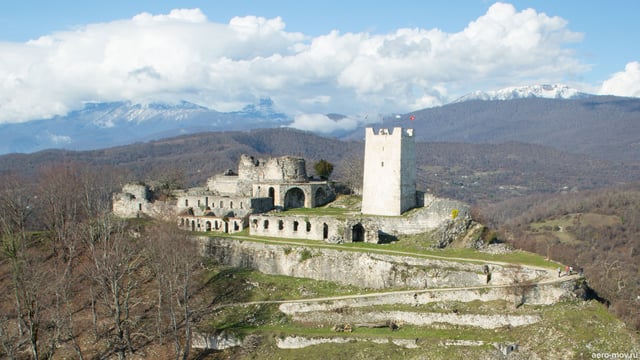
The medieval citadel of Anakopia today
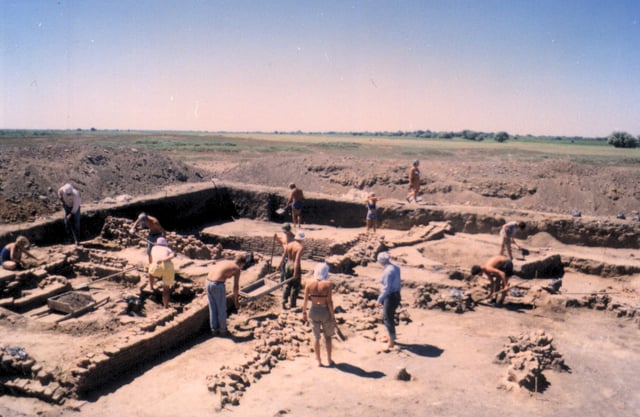
Excavations at Samosdelka, identified by some archaeologists with the Khazar capital al-Bayda/Atil[94]
After Marwan's 732 expedition, a period of quiet set in. Marwan was replaced as governor of Armenia and Adharbayjan in spring 733 by Sa'id al-Harashi, but he undertook no campaigns during the two years of his governorship.[80][85] Blankinship attributes this inactivity to the exhaustion of the Arab armies and draws a parallel with the contemporaneous quiet phase in Transoxiana in 732–734, where the Arabs had also suffered a series of costly defeats at the hands of a Turkic steppe power.[86] In the meantime, Marwan is reported to have gone before Caliph Hisham and remonstrated against the policy followed in the Caucasus, recommending that he himself be sent to deal with the Khazars, with full authority and an army of 120,000 men. When Sa'id requested to be relieved in 735 due to his failing eyesight, Hisham appointed Marwan to replace him.[80]
Marwan returned to the Caucasus determined to launch a decisive blow against the Khazars, but it appears that he too was unable to launch anything but local expeditions for some time. He established a new base of operations at Kasak, some twenty parsangs from Tiflis and forty from Bardha'a, but his initial expeditions were against minor local potentates.[87][88] In 735, Marwan captured three fortresses in Alania, near the Darial Pass, and the ruler of a North Caucasian principality, Tuman Shah, who was restored to his lands by the Caliph as a client ruler. In the next year, Marwan campaigned against another local prince, Wartanis, whose castle was seized and its defenders killed despite their surrender; Wartanis himself tried to flee, but was captured and executed by the inhabitants of Khamzin.[88] Indeed, Agapius and Michael the Syrian record that the Arabs and the Khazars concluded peace during this period, information which Muslim sources ignore or downplay as a short-lived ruse by Marwan designed to gain time for his preparations and mislead the Khazars as to his intentions.[89][86]
Marwan prepared a massive strike for 737, intended to end the war for good. Marwan apparently went to Damascus in person to persuade Hisham to back this project and was successful: the 10th-century historian Bal'ami claims that his army numbered 150,000 men, comprising regular forces of Syria and the Jazira, as well as volunteers for the jihad, Armenian troops under Ashot Bagratuni, and even armed camp followers and servants. Whatever the real size of Marwan's army, it was a huge force and certainly the largest ever sent against the Khazars.[90][89] Marwan first secured his rear by subduing the Armenian factions who were hostile to the Arabs and their client Ashot. He then pushed into Caucasian Iberia, driving its Chosroid ruler to seek refuge in the fortress of Anakopia on the Black Sea coast, in the Byzantine protectorate of Abkhazia. Marwan laid siege to Anakopia itself, but he was forced to retire due to the outbreak of dysentery among his troops.[90]
Marwan now launched a two-pronged offensive against the Khazars: 30,000 men (including most of the levies from the Caucasian principalities) under the governor of Derbent, Asid ibn Zafir al-Sulami, advanced north along the coast of the Caspian Sea, while Marwan himself with the bulk of his forces crossed the Darial Pass. The invasion met little resistance; the Arab sources report that Marwan had deliberately detained the Khazar envoy and only let him go with a declaration of war once he was deep in Khazar territory. The two Arab armies converged on Samandar, where a great review was held; according to Ibn A'tham, the troops were issued new clothing in white—the dynastic colour of the Umayyads—as well as new spears.[90][91] From there Marwan pushed on, reaching, according to some Arab sources, the Khazar capital of al-Bayda on the Volga. The khagan withdrew towards the Ural Mountains, but left behind a considerable force to protect the capital.[92] This was a "spectacularly deep penetration", according to Blankinship, but of little strategic value: the 10th-century travellers Ibn Fadlan and Istakhri describe the Khazar capital in their time as little more than a large encampment, and there is no evidence that it had been larger or more urbanized in the past.[93]
The subsequent course of the campaign is only provided by Ibn A'tham and the sources drawn from his work. According to this account, Marwan penetrated further north, and attacked a Slavic people called Burtas, whose territory extended up to that of the Volga Bulgars and who were Khazar subjects, taking 20,000 families (or 40,000 persons, in other accounts) captive. The Khazar army, under the tarkhan (one of the highest dignitaries in Turkic states), shadowed the Arab advance from the opposite shore of the Volga. As the Khazars avoided battle, Marwan sent a detachment of 40,000 troops across the Volga under al-Kawthar ibn al-Aswad al-'Anbari, which surprised the Khazars in a swamp. In the ensuing battle, the Arabs killed 10,000 Khazars, including the tarkhan, and took 7,000 captives.[95][96] Thereupon the Khazar khagan himself is said to have requested peace. Marwan reportedly offered "Islam or the sword", whereupon the khagan agreed to convert to Islam. Two faqihs were sent to instruct him on the details of the faith—the prohibition on consuming wine, pork, and unclean meat are specifically mentioned.[97][98] Marwan also took with him large numbers of Slav and Khazar captives, whom he resettled in the eastern Caucasus: some 20,000 Slavs were settled at Kakheti, according to al-Baladhuri, while the Khazars were resettled at al-Lakz. Soon after, the Slavs killed their appointed governor and fled north, but Marwan rode after them and killed them.[98][99][100]
Marwan's 737 expedition was the climax of the Arab–Khazar wars, but its actual results were meagre. Although the Arab campaigns after Ardabil may indeed have discouraged the Khazars from further warfare,[99] any recognition of Islam or of Arab supremacy by the khagan was evidently conditional upon the presence of Arab troops deep in Khazar territory, and such presence could not be sustained for long.[98] Furthermore, the credibility of the conversion of the khagan to Islam is disputed: al-Baladhuri's account, which probably is closer the original sources, suggests that it was not the khagan but a minor lord who converted to Islam and was placed in charge of the Khazars at al-Lakz—in itself, according to Blankinship, an indication of the implausibility of the conversion of the khagan, if the Khazar Muslim converts had to be removed to safety in Umayyad territory.[96] The conversion of the khagan is also apparently contradicted by the fact that c. 740 the Khazar court embraced Judaism as its official faith,[3] a decision which clearly owed a great deal to the determination of the Khazars to avoid assimilation by, and emphasize their independence from, both the Christian Byzantine and the Muslim Arab empires.[101]
Aftermath and impact of the Second Arab–Khazar War
Whatever the real events of Marwan's campaigns, warfare between the Khazars and the Arabs ceased for more than two decades after 737.[82] Arab military activity in the Caucasus continued until 741, with Marwan launching repeated expeditions against the various principalities of the northern Caucasus.[4][103][104] Blankinship emphasizes that these campaigns appear to have been closer to raids, designed to seize plunder and extract tribute to ensure the upkeep of the Arab army, rather than attempts at permanent conquest.[105] On the other hand, the British orientalist Douglas M. Dunlop considered that Marwan came "within an ace of succeeding" in his conquest of Khazaria, and that he "apparently intended to resume operations against the khagan at a later date", but this never materialized.[106]
Despite the Umayyads' success at establishing a more or less stable frontier anchored at Derbent,[44][105] they were unable to push any further, despite repeated efforts, in the face of vigorous Khazar resistance. Dunlop drew parallels between the Umayyad–Khazar confrontation at the Caucasus and that between the Umayyads and the Franks at roughly the same time across the Pyrenees that ended in the Battle of Tours, noting that, like the Franks in the west, the Khazars played a crucial role in stemming the tide of the early Muslim conquests.[107] According to Peter B. Golden, during the long conflict the Arabs "had been able to maintain their hold over much of Transcaucasia", but notes that despite occasional Khazar raids, this "had never really been seriously threatened. On the other hand, in their failure to push the border north of Derbent, the Arabs were clearly "reaching the outer limits of their imperial drive".[108]
Blankinship also highlights the limited gains made by the Caliphate in the Second Arab–Khazar War as disproportionate to the resources expended: Arab control was in reality limited to the lowlands and coast, and the land itself was too poor to recompense the Umayyad treasury. More importantly, the need to maintain the large garrison at Derbent further depleted the already overstretched Syro-Jaziran army, the main pillar of the Umayyad regime.[105] Eventually, the weakening of the Syrian army through its dispersion across the various fronts of the Caliphate would be the major factor in the fall of the Umayyad dynasty during the Muslim civil wars of the 740s and the Abbasid Revolution that followed them.[109]
Later conflicts
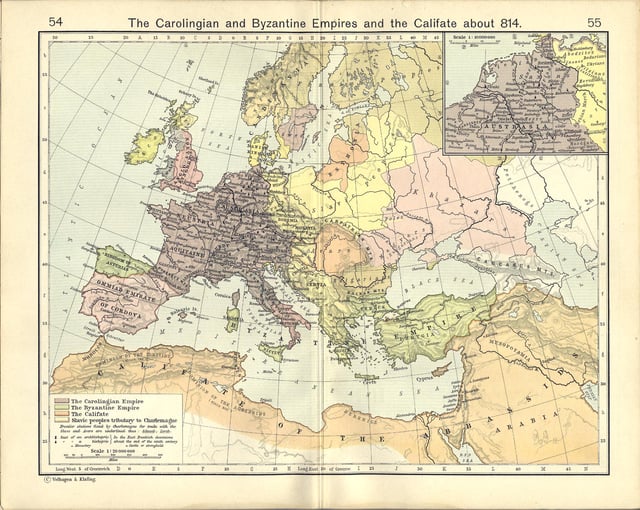
Map of Europe and the Mediterranean in the early 9th century, from William R. Shepherd's Historical Atlas. Abbasid Caliphate Khazar Khaganate Byzantine Empire Carolingian Empire
The Khazars resumed their raids on Muslim territory after the Abbasid succession, reaching deep into Transcaucasia. Although by the 9th century the Khazars had re-consolidated their control over Dagestan almost to the gates of Derbent itself, they never seriously attempted to challenge Muslim control of the southern Caucasus.[98] As Thomas S. Noonan writes, "the Khazar-Arab Wars ended in a stalemate".[110]
The first conflict between the Khazars and the Abbasids resulted from a diplomatic manoeuvre by the Caliph al-Mansur (r. 754–775). Attempting to strengthen the Caliphate's ties with the Khazars, in c. 760 he ordered his governor of Armenia, Yazid al-Sulami, to marry a daughter of the khagan Baghatur. The marriage indeed took place amidst much celebration, but she died in childbirth two years later, along with her infant child. The khagan suspected the Muslims of poisoning his daughter, and launched devastating raids south of the Caucasus in 762–764. Under the leadership of a Khwarezmian tarkhan named Ras, the Khazars devastated Albania, Armenia, and Iberia, where they captured Tiflis. Yazid himself managed to escape capture, but the Khazars returned north with thousands of captives and much booty.[98][111] A few years later, however, in 780, when the deposed Iberian ruler Nerse tried to induce the Khazars to campaign against the Abbasids and restore him to his throne, the khagan refused. This was probably the result of a brief period of anti-Byzantine orientation in Khazar foreign policy, resulting from disputes between the two powers in the Crimea. During the same period, the Khazars helped Leon II of Abkhazia throw off Byzantine overlordship.[98][112]
Peace reigned in the Caucasus between Arabs and Khazars until 799, when the last major Khazar attack into Transcaucasia took place. Chroniclers again attribute this attack to a failed marriage alliance.[98] According to Georgian sources, the khagan desired to marry the beautiful Shushan, daughter of Prince Archil of Kakheti (r. 736–786), and he sent his general Buljan to invade Iberia and capture her. Most of the central region of K'art'li was occupied, and Prince Juansher (r. 786–807) was taken off into captivity for a few years, but rather than be captured, Shushan committed suicide, and the furious khagan had Buljan executed.[113] Arab chroniclers, on the other hand, attribute this to the plans of the Abbasid governor al-Fadl ibn Yahya (one of the famous Barmakids) to marry one of the khagan's daughters, who died on her journey south, while a different story is reported by al-Tabari, whereby the Khazars were invited to attack by a local Arab magnate in retaliation against the execution of his father, the governor of Derbent, by the general Sa'id ibn Salm. According to the Arab sources, the Khazars then raided as far as the Araxes, necessitating the dispatch of troops under Yazid ibn Mazyad, as the new governor of Transcaucasia, with more forces under Khazim ibn Khuzayma in reserve.[98][112][114]
Arabs and Khazars continued to clash sporadically in the North Caucasus in the 9th and 10th centuries, but warfare was localized and of far lower intensity than the great wars of the 8th century. Thus the Ottoman historian Münejjim Bashi records a period of warfare lasting from c. 901 until 912, perhaps linked to the Caspian raids of the Rus' at about the same time, whom the Khazars allowed to pass through their lands unhindered.[115] Indeed, for the Khazars, peace on the southern border became the more important as new threats emerged in the steppes to challenge their hegemony.[116] The Khazar threat receded with the progressive collapse of Khazar power in the 10th century and defeats at the hands of the Rus' and other Turkic nomads like the Oghuz Turks. The Khazar realm contracted to its core around the lower Volga, and became removed from reach of the Arab Muslim principalities of the Caucasus. Thus Ibn al-Athir's reports of a war between the Shaddadids of Ganja with the "Khazars" in 1030 probably refers to the Georgians instead. In the end, the last Khazars found refuge among their former enemies. Münejjim Bashi records that in 1064, "the remnants of the Khazars, consisting of three thousand households, arrived in Qahtan [somewhere in Dagestan] from the Khazar territory. They rebuilt it and settled in it".[117]